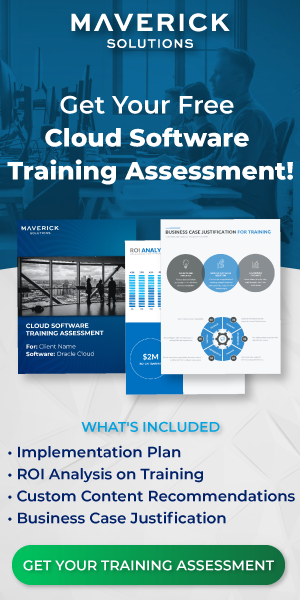How can hands-on training improve knowledge retention and increase user adoption on Oracle Cloud?
Hands-on Training and Knowledge Retention
Oracle Cloud and other Software as a Service applications are great because they make sure your company is up to date on any innovations and they keep your OpEx and CapEx low. However, to capitalize on all the benefits of Oracle Cloud or any other Cloud application, your company needs training.
Training is a form of learning. While learning is meant to broaden an understanding, knowledge gained from training is intended to be used continuously after the training1. Your company needs to keep users trained on your constantly updated Oracle Cloud system.
There are three basic learning/training modalities: doing, seeing, and hearing1. We will focus on training by doing because it is the best of the three basic learning/training modalities. Doing is a catch-all that encompasses hands-on training. Common methods of hands-on training include games-based training, internships/mentoring/job shadowing, role-play, and simulations. Simulation is a broad term that includes all training where skills are developed through repeated practice of the task without performing the real task1. Simulations can refer to anything from medical students operating on mannequins to our own content, which allows you to repeatedly perform tasks in Oracle Cloud without creating or removing data in your own servers.
In 2009, a study measuring knowledge retention was conducted comparing hands-on training to learning by demonstration (training by seeing or hearing). They found that when hands-on training was used a statistically significant number of students remembered the information 24 and 48 hours later compared to those who learned by demonstration2. This means that employees who get the chance to practice their tasks are much more likely to remember how to do them correctly than employees who are only shown what to do. Another study from 2016 found that when individuals encounter the same material repeatedly over time, they retain the information for longer than repetition of the same material at one time3. Taken together, the two studies indicate that immediate repetition of hands-on tasks followed by spaced repetition of those same tasks leads to the greatest knowledge retention.
With increased knowledge retention from hands-on training, user adoption on Oracle Cloud increases letting your team get back to peak efficiency, quickly.
Simulation-type Training vs. Other Hands-on Training
When your company onboards a new employee, mentoring or job shadowing makes sense because there is only one user who needs knowledge transfer. However, when it comes to adoption of a new toolset in the workplace, there is not a sufficient ratio of people who know how to use the tool and people who don’t know how to use the tool for such a training method to be effective. Simulations allow you to instruct multiple individuals at the same time, in the same way so each user can practice a task as many times as needed initially and as many times in the future as they need to accomplish the desired knowledge retention known to increase with spaced repetition. In addition to simulations being on-demand, there are many other benefits to simulation-type training for Oracle Cloud:
- A trainer does not need to be present.
- Users have face-to-face interaction with the material and the Cloud system.
- Simulations are highly interactive.
- Simulations are low cost and do not demand a significant amount of time1.
Suppose you have a large HR department with a payroll liaison for each department. All five of these liaisons have to run payroll for more than one hundred employees every week. You want to switch them to a new toolset that will make submitting the payroll easier. According to an ongoing study regarding the learning of languages, it takes many people actively repeating the same task more than 30 times before it can be considered “memorized”. 4 If we apply this to the five HR liaisons, this means it will take them 30 weeks or about 8 months of completing payroll before it is second nature. And remember, any mistakes will directly affect payroll since they’re practicing in a real system. Alternatively, they could complete simulations of the payroll submission process as many times as they want before the first new payroll submission is due to ensure that they do it correctly so the knowledge is considered “retained” prior to them ever entering the live system.User adoption is critical in a new system implementation. On-demand simulations empower your employees to train as needed until they are confident they know the task, increasing user adoption on Oracle Cloud.
At Maverick Solutions our mission is to provide the most robust training offerings at the best value for Oracle Cloud Customers. We know the importance of equipping employees with the necessary tools and training to succeed at any organization and keeping those tools and training up to date. This is why we create training content in multiple forms. Our simulations are one of our most popular training tools. We also offer printable user guides and in-app performance support. These resources help in times where a process only has to be run once a year. Why should an employee need to memorize how to submit the new benefits packages and retain that information year after year when they can just pull up a list of steps when they need to complete the task and follow along?
Training Simulations and User Adoption on Oracle Cloud
The question then becomes: how can we use hands-on training to increase user adoption on Oracle Cloud? We’ve already shown that hands-on training improves knowledge retention, but how does it lead to user adoption on Oracle Cloud?
Change can be scary, but it can be made less scary. A Harvard Business Review study found that when change is communicated in combination with emphasis on what is not changing, employees are more likely to embrace the change5. How can we apply this to user adoption on Oracle Cloud? Let’s use submitting payroll as our example. No matter what company you are at or what system you’re on, your team needs to gather the data, approve the data, and submit the data. Your team may have to learn new button look and placement as well as a different data format, but the process is still familiar.
Hands-on training in the new system before go live allows employees the opportunity to see that the process is essentially the same. Furthermore, you can utilize repetition of hands-on training to ensure that users are comfortable with the change prior to implementing it.
A large part of the fear of change is actually fear of the unknown and uncertainty. This is seen most obviously in scientific studies of the adoption of new technology such as mobile banking apps or mobile tv. A 2011 study of the adoption of mobile tv found that whether or not users adapted to the new technology was directly correlated with how the users perceived ease of use, access speed, and content quality. Perceived enjoyment, control, and focus were also key factors6.
Users can see for themselves how easy or difficult processes are if they are allowed to get into the system (or something that looks like and functions like the system) and practice as much as they want.
Another study from 2013 regarding user adoption of government services on the internet in Greece found that the most important factor influencing user adoption was “effort expectancy” which is similar to “ease of use”7. An employee cannot determine ease of use, or effort expectancy, from watching a demonstration or listening to a lecture. They can be told a new system is easy to use, but they are unlikely to truly believe it until they have gotten the chance to experience the change for themselves. By using a training tool that mimics your system, employees get an early look at what the new tool is and how it functions. In this way, you can increase user adoption on Oracle Cloud by providing hands-on, simulated training to ease the move from your legacy system to your new Oracle Cloud system.
Hands-on Training and ROI on Oracle Cloud
Hands-on, simulated, training increases knowledge retention and user adoption on Oracle Cloud by allowing employees to practice in a training tool that looks and functions like the system until they are comfortable.
Here at Maverick Solutions, we provide hands-on, simulated training for Oracle Cloud Software so that employees have the training support they need from go live to system update 32. We want your users to be able to reference training material as they need or refresh themselves on processes they infrequently use.
By investing in robust training, you are investing in both your change management program and your ongoing training program. With Maverick Solutions as your Oracle Cloud Training provider, you know your company has access to on-demand, hands-on, constantly updated training. You save money on instructors, minimize workplace disruptions, and gain all the benefits of knowledge retention and user adoption on Oracle Cloud. High user adoption leads to high ROI on your Oracle Cloud investment.
If you do use Oracle Cloud or are thinking of adopting Oracle Cloud, contact one of our training experts today to increase user adoption and ROI on Oracle Cloud.
- Martin, Barbara & Kolomitro, Klodiana & Lam, Tony. (2013). Training Methods: A Review and Analysis. Human Resource Development Review. 13. 11-35. 10.1177/1534484313497947.
- Hearns, Morna Kathleen & Miller, Barbara Kopp & Neslon, David L. (2009). Hands-On Learning versus Learning by Demonstration at Three Recall Points in University Students. OTJR: Occupation, Participation, and Health. 30(4). 169-171. 3928/15394492-20090825-01
- Kang, Sean H.K. (2016). Spaced Repetition Promotes Efficient and Effective Learning: Policy Implications for Instruction. Policy Insights from the Behavioral and Brain Sciences. 3(1). 12-19. 10.1177/2372732215624708
- Oaklander, Mandy. (2015). The Five Best Ways to Improve Your Memory. Time. https://time.com/4042569/how-to-improve-memory/#:~:text=According%20to%20this%20technique%2C%20%E2%80%9Cyou,you’ll%20remember%20it%20more.
- Venus, Merlijn & Stam, Daan & van Knippenberg, Daan. (2018). Research: To Get People to Embrace Change, Emphasize What Will Stay the Same. Harvard Business Review. https://hbr.org/2018/08/research-to-get-people-to-embrace-change-emphasize-what-will-stay-the-same
- Tao Zhou(2013) The effect of flow experience on user adoption of mobile TV, Behaviour & Information Technology, 32:3, 263-272, DOI: 1080/0144929X.2011.650711
- Voutinioti, Anastasia. (2013.) Determinants of User Adoption of e-Government Services in Greece and the role of Citizen Service Centres. Procedia Technology. 8. 238-244. 10.1016/j.protcy.2013.11.033



